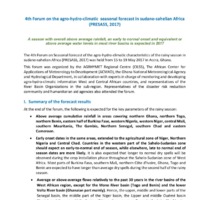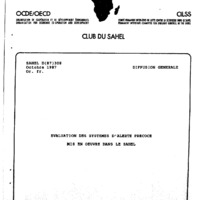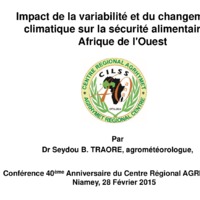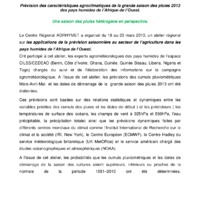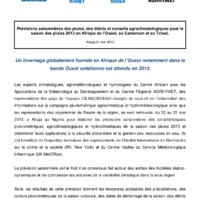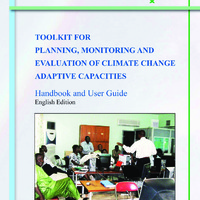Recherche
6 items
4th Forum on the agro-hydro-climatic seasonal forecast in sudano-sahelian Africa (PRESASS, 2017)
A season with overall above average rainfall, an early to normal onset and equivalent or above average water levels in most river basins is expected in 2017.
Impact de la variabilité et du changement climatique sur la sécurité alimentaire en afrique de l'ouest
Conférence 40ème Anniversaire du Centre Régional AGRHYMET Niamey, 28 Février 2015.
Prévision des caractéristiques agroclimatiques de la grande saison des pluies 2013 des pays humides de l’Afrique de l’Ouest.
Le Centre Régional AGRHYMET a organisé du 18 au 23 mars 2013, un atelier régional sur les applications de la prévision saisonnière au secteur de l’agriculture dans les pays humides de l’Afrique de l’Ouest. Ont participé à cet atelier, les experts agrométéorologues des pays humides de l’espace CILSS/CEDEAO (Benin, Côte d’Ivoire, Ghana, Guinée, Guinée Bissau, Liberia, Nigeria et Togo) chargés du suivi et de l’élaboration des informations sur la campagne agrométéorologique. A l’issue de cet atelier, les prévisions des cumuls pluviométriques Mars-Avril-Mai et les dates de démarrage de la grande saison des pluies 2013 ont été élaborées.
Prévisions saisonnières des pluies, des débits et conseils agroclimatologiques pour la saison des pluies 2013 en Afrique de l’Ouest, au Cameroun et au Tchad.
Un hivernage globalement humide en Afrique de l’Ouest notamment dans la bande Ouest sahélienne est attendu en 2013.
Toolking for planing, monotorin and evaluation of climate change adaptive capacities
Climate change is among the most serious threats confronting every person on the entire planet, and African populations are particularly vulnerable. All livelihoods suffer from the isolated or combined effects of many climate hazards that can negatively affect their productivity, and consequently food security and populations’ living conditions. Therefore, seeking to reduce the harmful effects of climate hazards relates directly to the fight against poverty. Reducing poverty and promoting human development depend in part on the reduction of greenhouse gas concentration in the atmosphere to prevent climate change (mitigation). But given that climate change is already happening and will continue to do so because of current and still-rising levels of carbon dioxide (CO2) in the atmosphere, it is also necessary to develop robust ways for natural and human systems to adjust in the face of future climate change effects (adaptation). Discussions on climate change now recognize that in addition to efforts to mitigate the phenomenon, strategies to enhance adaptation are a priority. This recognition has led to the unprecedented proliferation of many initiatives (projects, programs and policies) that relate climate change to development efforts. These initiatives, however, have so far hardly generated the expected outcomes. The disappointing results are due, in part, to the approaches and tools that were used to identify, plan, monitor and evaluate the initiatives. A study undertaken by the United Nations Economic Commission for Africa (Somda, 2010) on the shortcomings in the fields of monitoring and evaluation shows that these approaches are not sufficiently harmonized; they do not permit the drawing of consistent lessons that could improve the relevant formulation and implementation of new initiatives for climate change adaptation. This publication aims to resolve this issue by offering insights into harmonized approaches and tools for identifying, planning, monitoring and evaluating climate change adaptive capacities. It presents the theoretical approach and includes a practical users’ guide intended for development professionals, researchers and policy-makers. It contains a toolkit that harmoniously combines a number of existing approaches and tools for use at various intervention scales, and in this way defines a vision and a behavioural change strategy that are essential in the climate change adaptation process.
